AWS Cloud Architecture For Web Hosting
Last Updated :
15 Mar, 2024
Amazon Web Services (AWS) web hosting is the use of a package of web services – Amazon Web Services (AWS) which grants web sites and internet programs round-the-clock uptime, access to the all of the needed resources and so on. AWS has a bunch of services in the area of webworld hosting which includes Amazon S3 for hosting servers, Amazon EC2 for virtual devices, AWS Elastic Beanstalk for deployment and scaling web packages and Amazon CloudFront for content delivery. AWS hosting comes with scalability, dependability and versatility which helps organizations scale up their website hosting resources to match traffic request per need and only pay for what they use.
“Learn how Amazon Web Services (AWS) makes hosting a website powerful by allowing the users to easily add programming languages, documentation and automated processes into the virtual servers, in addition to the existing ease of use, flexibility, scalability, reliability of data, managed IT, cost efficiency, global availability, high performance, and innovative tools.”
.jpg)
Understanding Of Primary Terminologies
- In AWS Another major actor in the cloud market is Amazon Web Services, a cloud computing platform provided by the retail company.
- Amazon EC2: It is a type of cloud computing that is scalable and consists of virtual servers.
- Amazon S3: Reliable and safe cloud object storage organized by Simple Storage Service to deliver object storage function with focus on data permanence.
- Amazon RDS: It is a RDBMS for relational databases management like MySQL, Posgres, etc. These DDBMS are managed data services
- DDBMS: DMBS for relational databases such as MySQL, Postgres, et cetera. They are all data management services
- Amazon VPC: The AWS Virtual Private Network, represented by the VPC lets the users create isolated virtual networks within the flashily-large cloud environment.
- Amazon ELB: The Elastic Load Balancing is the mechanism designed to distribute incoming traffic to the instances running in multiple servers together for the purpose of increasing the ability of an instance existing (an instance being available) and of an instance recovering from the failure.
- Auto Scaling: Auto Scaling can also serve as an operating point for launching EC2 services on demand, and as per the traffic requirements.
Understanding The Building Blocks
- Amazon EC2 (Elastic Compute Cloud): Grants their desktop applications virtual machines (VMs), the basic technological layer that then enables users to put the required computing capabilities which include web servers and databases in the cloud and pull them down to use whenever is needed.
- Amazon S3 (Simple Storage Service): Distributing media, including webpages, media resources, and backups of web app programs at low price fixed scale object storage.
- Amazon VPC (Virtual Private Cloud): Facilitates peer-to-peer networking between virtual cloud appliances to provide ultra-high level security by considering logical network segmentation techniques in the AWS cloud. This is also a plus due to the fact that one now has exposure and control over such resources.
- Amazon Route 53: The managed domain native service that directs the user traffic to the application which is hosted on AWS by the web browser.
- AWS Elastic Load Balancing (ELB): Right the traffic from outside the public network by interconnecting 2 or more EC2 instances for a maximum of uptime and scalability for your app.
- Amazon CloudFront: The role of CDN (Content Delivery Network) is the catching place content that is static stored. It will be duplicated and distributed to locations near the edge of each region and close to users. Therefore, the response latency will be lessened, thus improving the site performance to end users.
Find Web Hosting Solutions On AWS
Amazon Web Services (AWS) has several internet web hosting solutions that vary in interest and usefulness. Here’s a top-level look at the many types of internet web hosting available from AWS.
1. Static Website Hosting
- Ideal For: Usually simple websites with passive content e.g. Blogs, portfolios, landing pages.
- Services: Uses Amazon S3 (Simple Storage Service) primarily to store your online web files. You can configure S3 buckets for web hosting i.e. Make your websites accessible by URL This is publicly available.
- Pros: Low cost, highly scalable and easy to configure.
- Cons: There is less functionality in this compared to dynamic internet hosting options.
2. Web Application Hosting
- Best For: Dynamic websites that involve server-side processing and database interactions such as e-business systems, content and content management systems (CMS), or pure applications.
- Services: Integrate offerings with Amazon EC2 (Elastic Compute Cloud) for virtual machines that typically host websites of your internet server software; Amazon RDS (Relational Database Service) for managing databases; and also Amazon Elastic Load Balancing (ELB) which helps distribute traffic in many cases.
- Pros: This option offers more flexibility, customization and flexibility than static website hosting.
- Cons: It needs more configuration and management compared to simpler options.
3. Serverless Website Hosting
- Appropriate For: One app or website that requires dynamic adjustments to traffic based on the events or receiving periodic data through data updates.
- Services: Uses AWS Lambda fasts to load codes for executios whenever events like user prompts arise. Other than that, an Amazon environment can be used to administer the API endpoints of your app through use of its API Gateway.
- Pros: It claims big scalability, reasonable cost through paygo model and not without supervision from the guiding servers.
- Cons: It wouldn’t be a suitable solution where it comes to multidimensional assignments or those defined by high-level requirements.
- Ideal for: Businesses that are pursuing hassle-free and offered by the hosting company.
- Services: Amazon Web Services (AWS) Elastic Beanstalk makes the development process simpler and faster. It provides an easy way to deploy and control different kinds of web applications and frameworks like WordPress, Node.js, and Java.
- Benefits: Preprogrammable, easy managable and having an automatic scaling feature alongside with great security protection.
- Drawbacks: Having less options provided compared to manual deployments and possibly the higher cost associated with the other option.
The best type of web hosting on AWS depends on your specific needs and website requirements. Consider factors like:
- Website Complexity: Static Content vs. Dynamic functionality.
- Website Request Demand: The current loading demand is low/high.
- Management And Maintainance: Ease of building methods and the server management with configuration.
- Budget: Low cost implication of different services and resources such as; service packages and control panels which are shared among guests.
Step-By-Step Processes Of Hosting A Website On AWS Cloud
Now after knowledge what are the types of website hosting services available in AWS, we could learn how to host a website on AWS server free of value.
Step 1: First sign on or log in to your AWS account, If you don’t have an AWS account, go to AWS professional internet site, sign on for a unfastened account. If you have already got an account, certainly log in and click on services.
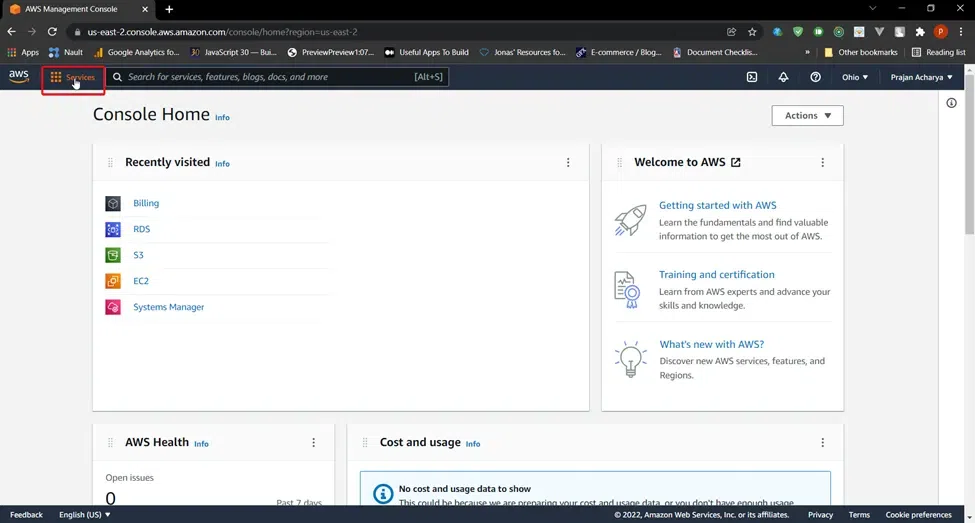
Choosing a web web hosting carrier: AWS offers diverse internet website hosting services, inclusive of Amazon S3, Amazon EC2, and Elastic Beanstalk. For this situation, permit’s usage of Amazon S3, that’s genuinely easy and exquisite for hosting static websites.
Step 2: Creating an Amazon S3 bucket: An S3 bucket is wherein your website files may be saved. To create a bucket, comply with these steps:
aws s3api create-bucket \
--bucket your-bucket-name \
--region your-region \
--create-bucket-configuration LocationConstraint=your-region
Step 3: In the AWS Management Console, navigate to the Amazon S3 service as shown in below screenshot.

Step 4: Click “Create bucket”.

Step 5 : Enter a completely unique call to your bucket and pick a vicinity.
Step 6 : Click “Create”
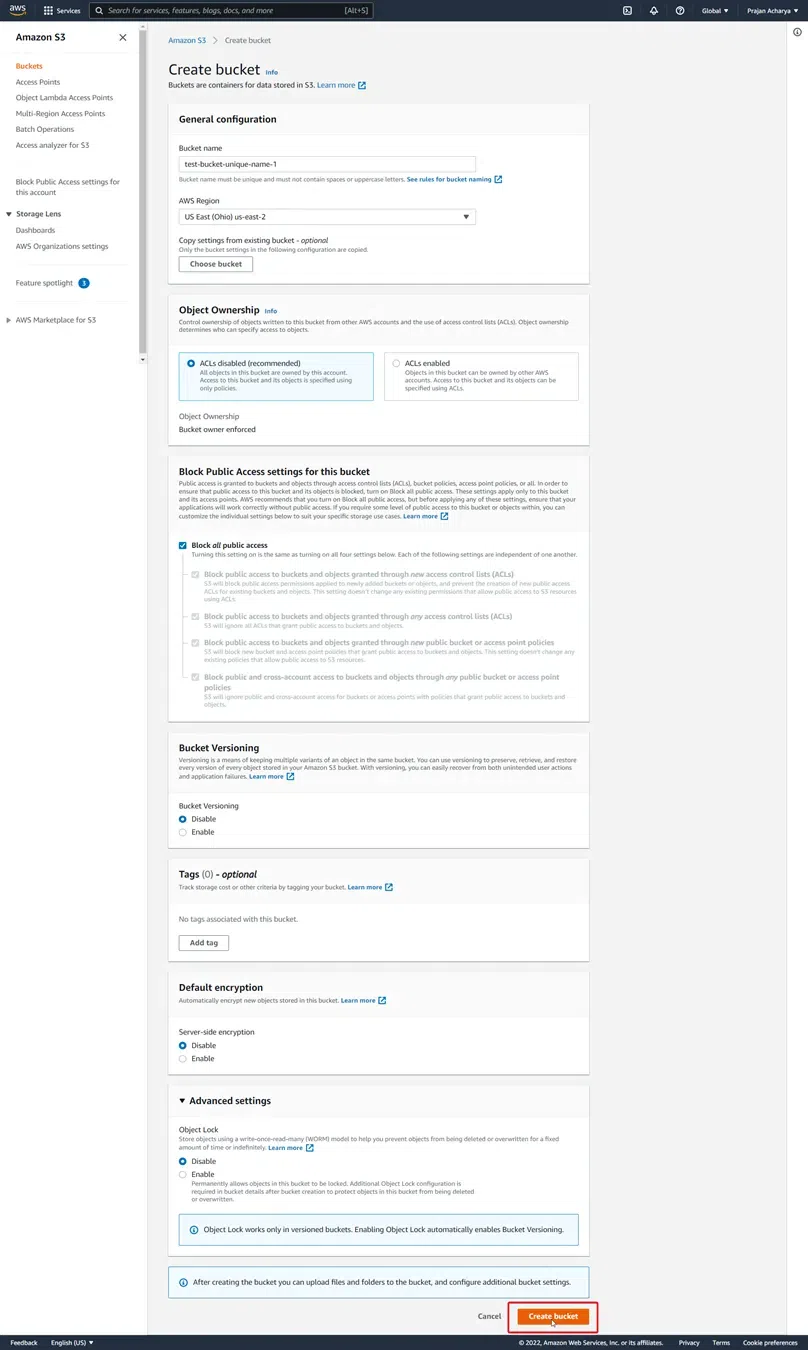
- Uploading your internet site files, Now, it’s time to add your internet site files (HTML, CSS, JavaScript, pix, etc.) on your S3 bucket.
aws s3 sync path/to/website-files s3://your-bucket-name
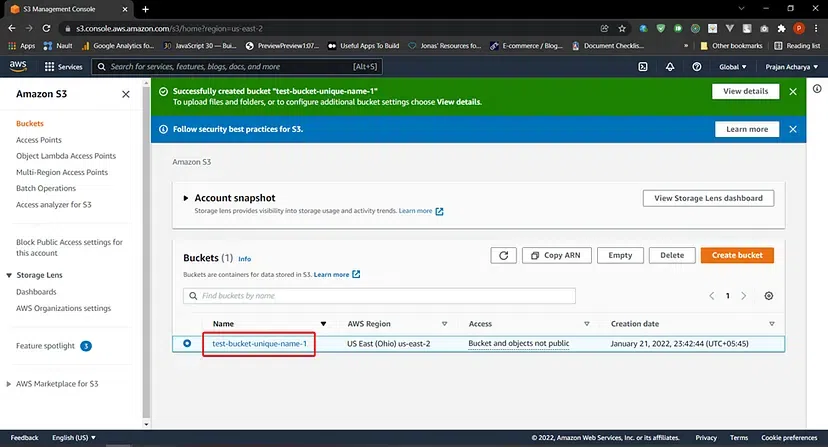
Step 7: In the S3 bucket web page, Click “Upload“
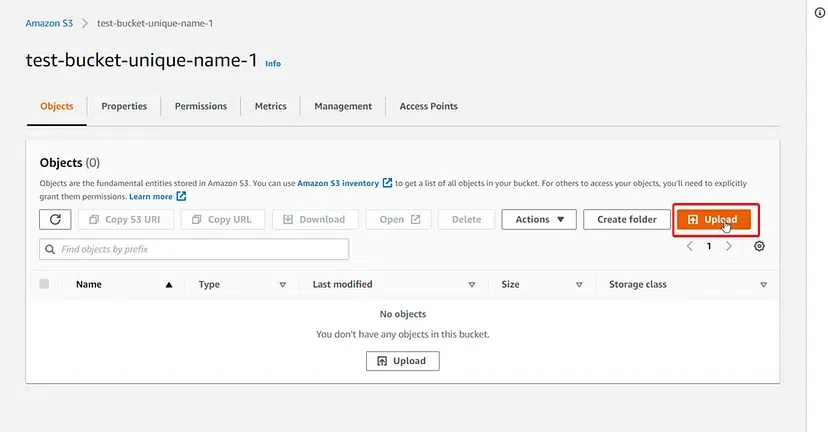
Step 8: Select the files you need to upload and click “Upload”

- The following screenshot illustrates about the uploading the file in Amazon S3 bucket.
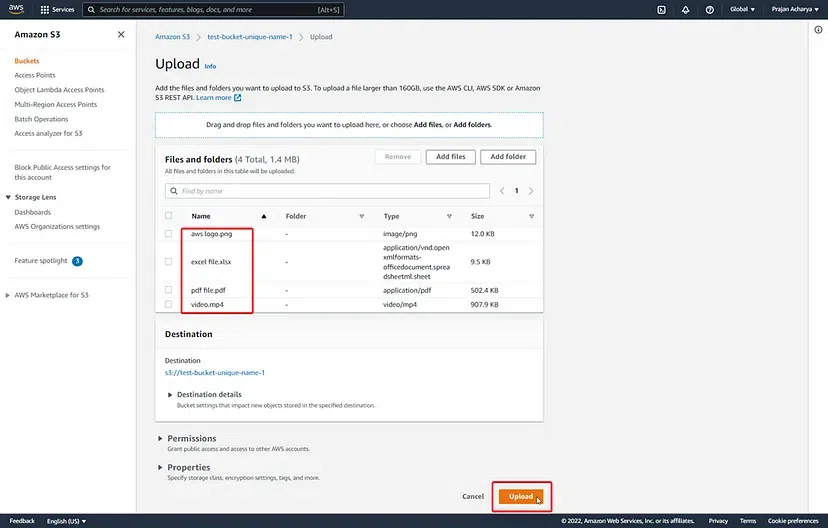
- After once uploaded viewing the summary of the uploaded file in the bucket.

Step 9: After Once configure your bucket settings. Now in order to make your website on hand on the net, you need to configure your bucket settings
- Use the following command to configure your bucket for static website hosting (replace your-bucket-name with your bucket name):
aws s3 website s3://your-bucket-name --index-document index.html
Step 10: In your S3 bucket web page, click the “Permissions” tab.
- Add a policy that permits public get admission to to your bucket and its contents. You can find the coverage template for “Static Website Hosting” within the AWS documentation.
Step 11: Click “Save”.
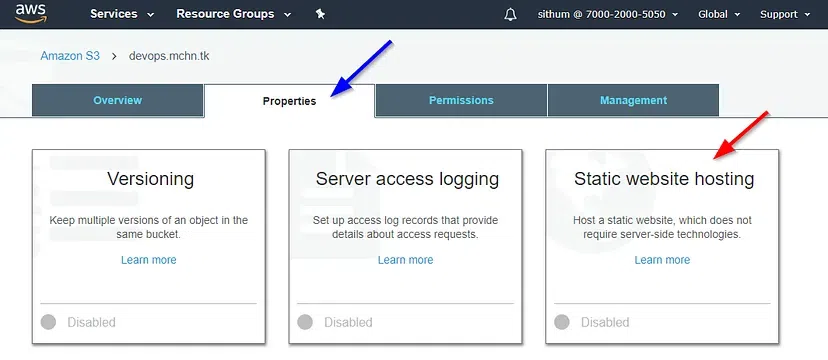
- Set up a custom area (non-obligatory): If you need to use a custom area name to your website, follow these steps:
Step 12: In your S3 bucket web page, click on the “Properties” tab.
Step 13: Find the “Static hosting” phase and click “Enable website hosting” (fig-11)
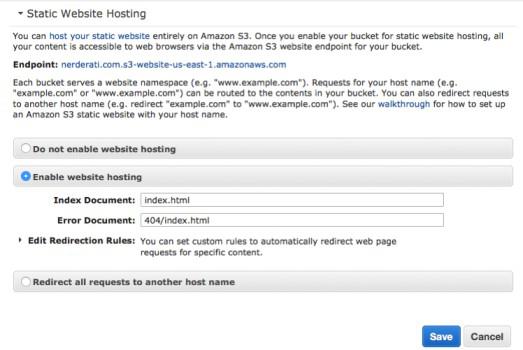
Step 14: Enter your custom area name inside the “Index Document” field.
Step 15: Click “Save”
- Congrats! Your static website is launched in AWS S3. Now visit the domain on your favorite web browser to access your website.
What Are The Advantages Of AWS For web Hosting Site?
- Amazon Web Services (AWS), in short, brings to the table many advantages whenever it comes to web hosting, making it the envy of international players in this sector.These advantages include:
- Ease Of Use: AWS attracts the user with the provided management interface, the AWS Management Console, which makes setting up the hosting site faster and easier whenever it is needed.
- Flexibility: AWS provides the choice regarding operating systems, programming languages, web application platforms and other utilities so users can customize their applications. The system gives the user flexibility to use what it wants from their set of services.
- Scalability & Elasticity: AWS employs Auto Scaling along with Elastic Load Balancing mechanism to maintain the adjustment and conform to uneven traffic deviations. In the end, it is these skills set which build the prevailing talent.
- Reliable Encryption & Security: AWS, AWS guarantees the confidentiality and protects information by applying complex cryptographic techniques and high security measures.
- Managed IT Services: AWS maintains all of the IT components for the client, therefore relieving the client from the burden of maintaining or managing them.
- High Availability: Architecture of your website like installing redundancy or introducing fault tolerance can decrease downtime and keeps your website accessible for users.
- Cost-Effectiveness: Get billed only for the resources used with a high level of performance and lower costs by avoiding the capital outlays needed to implement in-house infrastructure. AWS offers On demand pay, pay as you go, optimizes your cost and avoids investment upfront in the classic on-premises infrastructure just like your home electric bill.
- Security: Use of sophisticated security mechanisms as well as the best practices to shield your web application and sensitive data from unauthorized client access and potential threats is the utmost priority.
- Global Availability: AWS is responsible for about 1% of the world’s total electric power consumption. This means that if you are a client and you are deploying an application, the distribution of this application closer to your target audience will improve response time and will reduce the latency as well.
- High Performance: By opting for AWS their cloud infrastructure is built to a high standard thus making the website performs better than when a cheaper nor traditional hosting solutions are applied.
- Innovative Tools: As the primary customer of such innovations direct investments, AWS has the advantage in competition. A Pay-as-you-go basis instead of the upfront investment is the major merit of Amazon cloud services which is likely to facilitate startup companies.
Enhancing Security
- Security Groups: The utilization of security groups enables you to control inbound and outbound communication for resources within the VPC. Build Firewall rules that are security-guaranteed for an extended security.
- IAM (Identity and Access Management): Authenticate and authorize user access and permissions to AWS resources, so that your web hosting environment is only accessible by the people who have been granted permission to do so.
In the cloud computing sphere, a well-designed AWS cloud architecture is an indispensable factor for viable operations.
Real-World Usage Example
Imagine a webpage that experience spikes in traffic during any sales season like the end-year holiday seasons. With AWS cloud, auto-scaling can be made available anytime, such as when more EC2 instances are need to manage the peaked site traffic, meaning the website will run smoothly throughout the busy shopping season. Along with controlled user sever connection using Security Groups.

AWS Cloud Architecture Web Hosting – FAQ’s
What Is Auto Scaling In AWS?
Auto Scaling is a feature which automatically adjusts the number of EC2 virtual machines as per predefined conditions liketraffic volume or CPU utilization so as to lead to better, more efficient performance and reduced costs.
Why Such A Framework Called VPC In AWS?
VPC enables you to create network separation and security policies with AWS cloud infrastructure. Simultaneously, it gives you the opportunity to forge the network structure of your choice.
Can Static Site Be Hosted At AWS?
Yes, you can store your HTML files, CSS stylesheets, JavaScript scripts and other assets in S3 buckets on AWS, which will act as a place to do static website hosting.
How Is ELB Beneficial In Terms Of Reliability When Using Web Hosting On AWS?
ELB sends traffic in the right direction by sharing it among several EC2 instances, which give greater availability, as it redirects requests to non-working systems.
How RDS Differs From A Self-managed Communal Of Databases In What Ways?
RDS reduces time consumption to manage DBA related tasks like backups, patching, scaling, and monitoring, besides providing high availability through its automatic failover mechanism.
Share your thoughts in the comments
Please Login to comment...